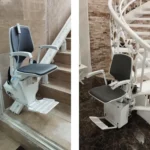Will My Stairlift Work in a Power Cut? Battery Myths Debunked
Everything you need to know about DC batteries, runtime, charging and replacement cycles.
- AC vs DC Stairlifts – A Two-Minute History
Older stairlifts ran directly on mains electricity. If the power failed, the chair stopped mid-flight—clearly a hazard. From the late 1990s forward, nearly all reputable manufacturers switched to 24 V DC sealed batteries that recharge automatically at the rail’s charge points.
Benefits of DC
- Ride during black-outs (battery backup)
- Smoother start/stop without jolting
- No exposed wires along the rail
- Quieter motor (< 50 dB)
HMK’s straight and curved models use two 12 V 9 Ah VRLA batteries* wired in series for 24 V output.
*Valve-Regulated Lead–Acid, the same chemistry used in UPS systems.
- How Long Will the Lift Run Without Mains Power?
From factory tests and real-world telemetry (HMK-Link IoT), a fully-charged battery pair delivers:
| Model | Rated Load | Trips* on Full Charge |
| Straight K 2 | 130 kg | 18–22 one-way trips |
| Curved Alpha | 125 kg | 15–18 one-way trips |
| Outdoor | 130 kg | 12–15 trips (cold weather may reduce by 10 %) |
*One-way = bottom→top or top→bottom.
If you have optional powered swivel or footrest, each actuation consumes ≈ 5 % of a full up-run, so budget accordingly.
- Five Common Battery Myths
| Myth | Reality |
| 1. “Bigger batteries mean faster rides.” | Speed is motor-controller limited (0.08 m/s). Larger capacity only extends runtime. |
| 2. “You should switch off the charger to save energy.” | Chargers draw < 4 W on standby (≈ €5 / year). Turning them off lets batteries sulphate and shortens life. |
| 3. “A beeping chair means the motor is faulty.” | 90 % of beeps indicate low charge or unplugged charger. Plug in and wait for green LED. |
| 4. “Lithium batteries are always better.” | Lithium packs need complex BMS and fire certification. VRLA are safer, cheaper, easier to ship. |
| 5. “Outdoor units need special batteries.” | Same VRLA chemistry works; outdoor models add a thermal-pad heater below 0 °C. |
- Extending Battery Life – Simple User Tips
- Park on a charge point. HMK rails charge at both ends; stop fully until you hear the click.
- Avoid long idle off-charge. If storing > 2 weeks, switch the carriage breaker OFF and unplug the charger. Recharge 24 h before reuse.
- Keep temperature stable. Ideal range 10–25 °C. In freezing garages, use the optional battery heater kit.
- Monthly exercise ride. Run one full up-and-down cycle to keep plates desulphated.
- Annual load test. Part of HMK’s 42-point service; technician measures voltage drop under 100 % load.
- Diagnosing Battery Issues (LED Codes & Beeps)
| Symptom | Likely Cause | Quick Action |
| Short beep every 1 s when parked | Not on charge station | Drive fully into top/bottom landing. |
| Continuous beep (≈20 s) after ride | Charger unplugged / circuit breaker off | Check wall socket & breaker. |
| Red LED on carriage | Voltage < 22 V | Call service if persists after 4 h on charge. |
| Lift stops mid-stairs, won’t restart | Deep-discharged battery | Manual handwheel to landing → recharge → service. |
Full LED map in our Owner’s Manual (Downloads section).
- When Should I Replace My Batteries?
- Runtime drops below 50 % of original spec.
- Voltage under load < 20 V (measured by technician).
- Visible swelling or vent leakage (rare).
Typical lifespan is 3–5 years under normal use. HMK service vans stock certified UL94-V0 flame-retardant replacements and swap both batteries as a matched pair.
- Environmental & Safety Notes
- VRLA batteries are fully recyclable. HMK removes old units under WEEE directive.
- Never incinerate; internal gases may rupture the case.
- For air cargo, batteries ship as UN 2800 – Wet, Non-Spillable; no hazardous surcharge.
- Chargers are double-insulated and CE/UL listed; do not bypass fuses.
- FAQ Snapshot
| Question | Answer (≤ 35 w) |
| Can I use a generator to charge? | Yes—chargers accept 90–265 V AC, pure or modified sine. |
| Will cold weather kill the battery? | Capacity falls 10 % per −10 °C; heater keeps pack above +5 °C. |
| Is it safe to leave on charge when away? | Absolutely—the smart charger switches to float at 27 V. |
| Can I upgrade to AGM gel cells? | Our standard VRLA are AGM-type; no upgrade needed. |
- Quick Reference & Next Step
- Runtime on full charge: 15–22 trips
- Replace every: 3–5 years or < 50 % runtime
- Never: Switch off charger for long periods


